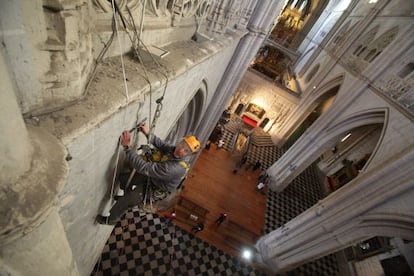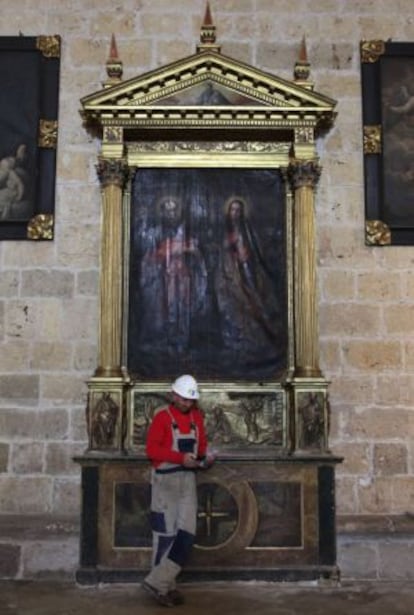Spain’s first smart cathedral
San Antolín in Palencia has been kitted out with 130 wireless devices They help protect the building from damp, cracks and even wood-munching bugs


A small army has been deployed inside Palencia's cathedral. The troops are strategically distributed along the corners, on the roof, between cracks, behind the altarpiece, inside the chapels, in the archive and down in the crypt. They are 130 black wireless devices, most of them no bigger than a pack of cigarettes, and they go perfectly unnoticed among the few visitors who show up at the Catholic temple of worship on this cold and windy morning.
The devices hold sensors that monitor the indoor temperature and humidity, and detect any changes to the cracks in the walls of a building that will be seven centuries old in seven years' time. These guardians are also programmed to alert humans about fires and any wood-eating insects found feasting on the images that adorn this enormous space.
San Antolín, an impressive 14th-century Gothic construction, is popularly known as "the unknown beauty." Now it is hoping to become famous as Spain's first intelligent cathedral.
"There is none like it in Europe, either," according to the Santa María la Real Foundation, which has been restoring Spain's cultural heritage - especially art in the Romanesque style - for nearly four decades.

The Palencia project began last summer with EU funding, explains the foundation's general director, Juan Carlos Prieto. Once it is completed a few days from now, the foundation is due to do the same thing at the Museum of Basque History in Bayonne (France) and in a small church in the Portuguese town of Roriz. Back in Spain, the next candidate for intelligent wiring is the monastery of Yuso, in San Millán de la Cogolla (La Rioja).
The foundation - which covered the costs of the trip to report on this story - already had experience in restoring and carrying out surveillance on around 100 small Romanesque churches. But dealing with a cathedral 130 meters in length, "with a lot of stone, altarpieces, paintings, heating problems and so on," was a whole new ball game.
Around 30 people were employed in the task of "finding the building's heartbeat," at a cost of around 60,000 euros. The sensors communicate with a computer located in the vestry, which in turn relays the information to a server at the foundation headquarters in Aguilar de Campoo.
"They don't only send data, but also interpret it, so the moment they detect that a certain level has been surpassed, they issue an alert and we act as soon as possible," says Prieto, noting that the focus is now on preventing, rather than fixing the damage. Until recently, however, the mentality in heritage conservation was the opposite: "Acting after the fact, when the damage was already done. This entailed great expense, since failing to monitor the repairs meant that things would get damaged again. Heritage should not be a burden, it should be an engine of growth."
As for San Antolín, "the greatest damage is on the north side, where the winds blow stronger and the rain beats harder," explains the cathedral dean, Mateo Aparicio. "Yet this cathedral has always been well cared for." It even got lucky during the Napoleonic invasions of the early 1800s, when French troops systematically destroyed or took away religious art. "The general in command of the troops liked to gaze upon the chapels in the apse, so he ordered the temple respected."
Don Mateo, as parishioners call him, is delighted with the new technology, but not all members of the cloth are equally enthusiastic about the upgrade, the foundation has found. Some even frowned upon having the stone polished. As for the potential attraction for visitors of the concept of a "smart" cathedral, Don Mateo is adamant. "There is a temptation to turn a church into a tourism stop. It's all right for people to come, but we want to make saints, not tourists."
As he utters these words, four tourists contemplate one of the highlights of the cathedral, the Renaissance altarpiece in the main chapel, featuring the work of Juan de Flandes, a Flemish painter who died in Palencia in 1519. Behind the artwork there is a sensor that's been programmed to detect insects by setting up a trap made of soft, delicious wood. "When the bug goes for it, [the sensor] detects it and warns us. Wood-eating insects are very harmful because they make tunnels. Elsewhere we have come across altarpieces that had nothing but the paint left; the entire back part had been eaten away," says Prieto.
One of the most noteworthy moments of the Palencia project was when a worker had to rappel down the wall to set up a "crack-o-meter" inside a fissure running down the triforium (an upper gallery with windows) high on the central nave. "We want to know whether that crack is getting bigger, and to determine where it's coming from," explains Prieto.
Meanwhile, the archive, though less visible to visitors, enjoys great surveillance. Around 50 sensors programmed to detect fire and water protect songbooks, historical documents such as the foundational chart of an abbey in 932, books documenting how the cathedral was built, and contracts with the artists in charge of making it beautiful.
A woman suddenly approaches the chapel of the Sacrarium and pulls hard on the ponytail of a likeness of a young woman symbolizing fidelity. No alarms go off, however, and the sensors remain quiet. It appears this is a tradition among the people of Palencia, who do it to make their wishes come true.
Tu suscripción se está usando en otro dispositivo
¿Quieres añadir otro usuario a tu suscripción?
Si continúas leyendo en este dispositivo, no se podrá leer en el otro.
FlechaTu suscripción se está usando en otro dispositivo y solo puedes acceder a EL PAÍS desde un dispositivo a la vez.
Si quieres compartir tu cuenta, cambia tu suscripción a la modalidad Premium, así podrás añadir otro usuario. Cada uno accederá con su propia cuenta de email, lo que os permitirá personalizar vuestra experiencia en EL PAÍS.
¿Tienes una suscripción de empresa? Accede aquí para contratar más cuentas.
En el caso de no saber quién está usando tu cuenta, te recomendamos cambiar tu contraseña aquí.
Si decides continuar compartiendo tu cuenta, este mensaje se mostrará en tu dispositivo y en el de la otra persona que está usando tu cuenta de forma indefinida, afectando a tu experiencia de lectura. Puedes consultar aquí los términos y condiciones de la suscripción digital.
Últimas noticias
Reinhard Genzel, Nobel laureate in physics: ‘One-minute videos will never give you the truth’
Pinochet’s victims grapple with José Antonio Kast’s rise in Chile
From digital curfews to blocking apps: How technology experts protect their children online
Why the price of coffee has skyrocketed: from Brazilian plantations to specialty coffee houses
Most viewed
- Pablo Escobar’s hippos: A serious environmental problem, 40 years on
- Why we lost the habit of sleeping in two segments and how that changed our sense of time
- Trump’s obsession with putting his name on everything is unprecedented in the United States
- Charles Dubouloz, mountaineering star, retires at 36 with a farewell tour inspired by Walter Bonatti
- The Florida Keys tourist paradise is besieged by immigration agents: ‘We’ve never seen anything like this’








































